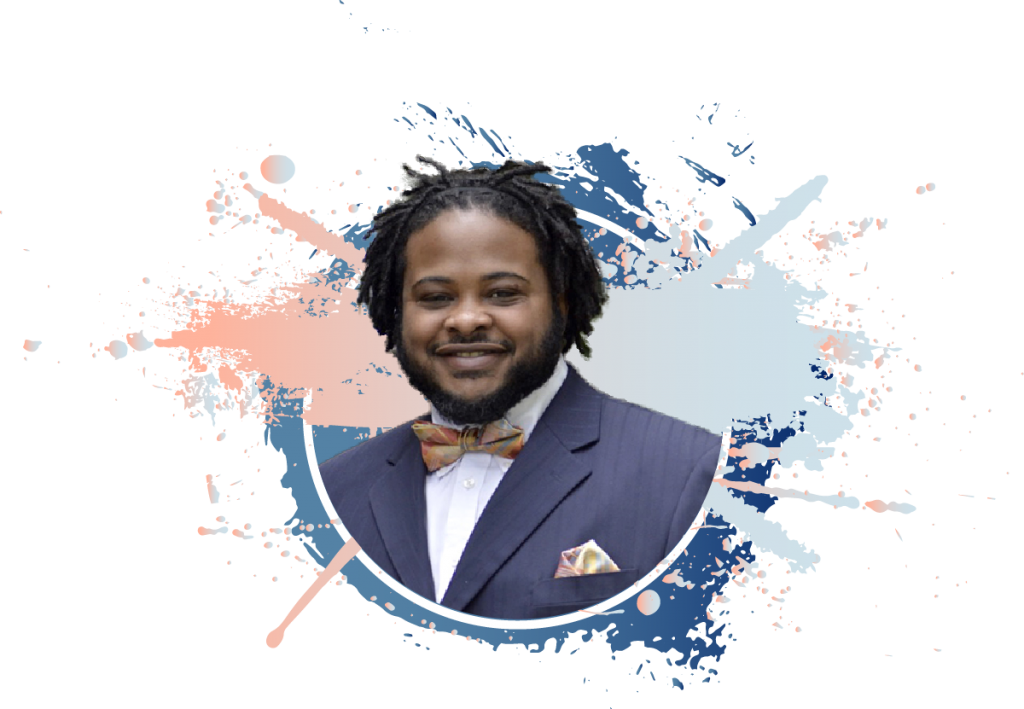
Tyrone Wise, a staff member at UC Berkeley’s Haas School of Business, builds campus community through conversations, including conversations about race. Tyrone is an expert listener who has used the power of understanding to make change not just in his current role at Berkeley, but also as a student conduct officer and in other contexts in higher education.
After hearing Tyrone on UC Berkeley’s Fiat Vox podcast, CUC Board member Melanie Rowen followed up to learn more about how he does his powerful and transformative work. This conversation has been edited and condensed.
Melanie Rowen [MR]: The Center for Understanding in Conflict, in addition to helping people learn the concrete skills of mediating, is focused on the internal work we need to do to be able to show up effectively in conflict conversations. In your student conduct work, or in your work at Berkeley talking about race, how do you go inside yourself to manage the situation when someone says something that is difficult [for you]?
Tyrone Wise [TW]:
In a weird way I get excited about it, because it allows me to challenge myself and to really get into listening to what that person is saying, and hearing what they’re telling me. Because they’re telling me a lot more than they realize they’re telling me. A lot of it is just misinformation, a lot of it is stereotype, a lot of it is bias, a lot of it is just frustration, anger, lived experiences that are misguided or misplaced.As they’re telling me their stories, I’m processing what they’re telling me, and I’m hearing anger. And I say, “I hear what you’re saying and it sounds like…” And I’ll give it back to them, what I’m understanding that they’re saying to me, in their terms. And it’s interesting watching their body language shift, because they’re like, you heard me and you’re not reacting to that. I am able to hear emotion and move that.
I never want to discount a person’s feelings. But I also want to use that as an opportunity to educate them. “Okay, this is what you say, where did that come from? What would you have done differently, or how did that make you feel?” And that unpacks that emotion, to where I can get to that root, to what really is the cause of that person’s feeling. And now let’s pick at that, and show you how that was misplaced anger, or misunderstanding, or a stereotype, or bias that is incorrect.
Once you’re able to remove that barrier or that wall that person comes in with—and Daryl Davis in his film Accidental Courtesy does a great explanation of that—you’re able to have that personal conversation, and see that person as a person. And once that is able to happen, the conversation shifts, because now I can be vulnerable and we can actually share some intimate conversations. And in doing that you create a relationship that is more caring, more giving and not so guarded and aggressive. And I think that’s the skill I have that has made the biggest difference.
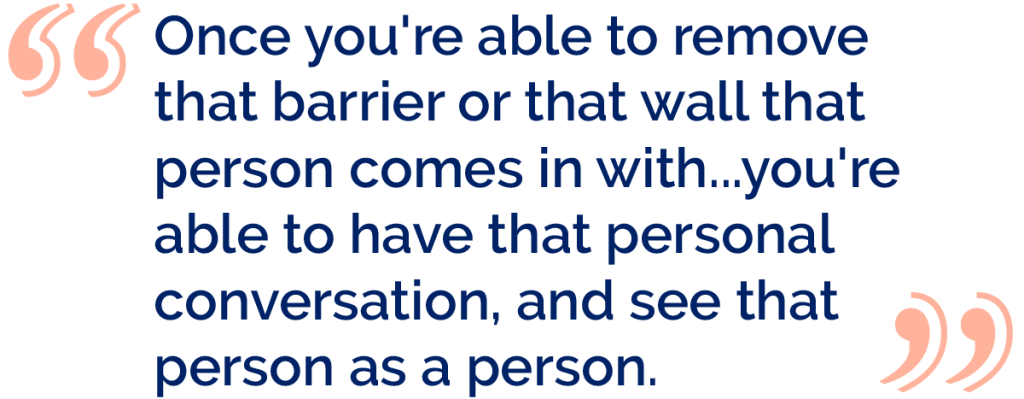
MR: What about situations where you’re working with people in conflict? How do you approach having a multi-party conversation?
TW: One way that I do it is I try to find a common ground. I try to find what each person is saying. And humans are so cyclical, so it’s just trying to find where the common ground is in that conversation, and then holding on to that and letting that be the thread that keeps us on track.
Sometimes I’ll provide reading materials or videos. Or just more follow-up. It all depends on the relationship and how I feel the conversation is going. But I think the biggest piece is just listening, finding that common thread that allows us to keep that conversation on track to what we want to address.
MR: Are you often coming into conversation where a specific thing has occurred, or there’s a specific thing that needs to be addressed? Or are you coming in and assessing with people, what is it that we’re talking about? And how often do you bring your own agenda to that, and how often is that driven by the other folks there?
TW: Both—sometimes I come in with the idea of where I want to go, and sometimes I come in and just say, tell me what’s going on, allowing both people to speak and not be interrupted by the other. I allow them to talk, say their piece, to me, not to that other person but to me. But so that other person can hear. And then when they tell their story, they’ll give their piece, again uninterrupted by the other, and it allows everybody to hear the same story. From there I’m able to unpack.
One of the statements that I’ll often use—my wife gets mad when I say this—but I say, your perception is not always the reality. Because we can see something and automatically tell ourselves, this is what it is, not realizing that there’s more to that story that we don’t have.
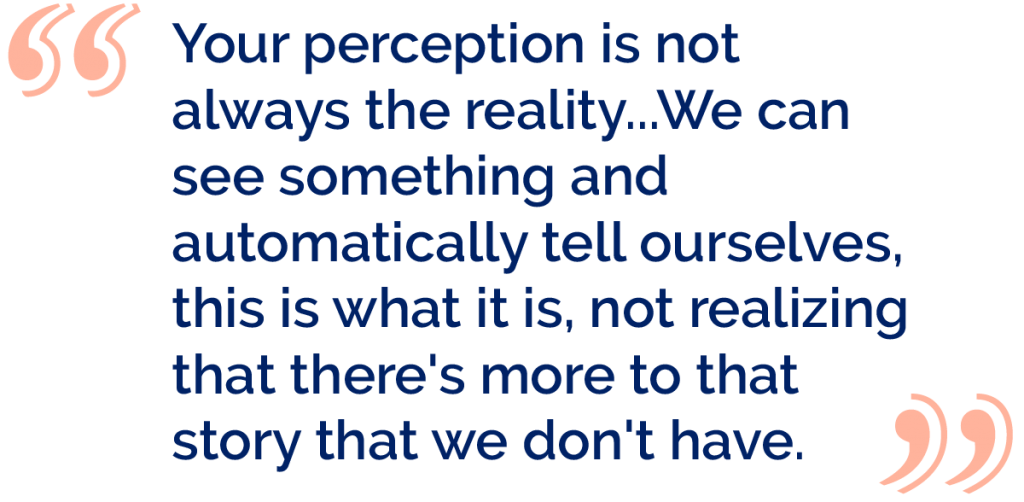
I often used that in student conduct, because you would read a [student’s] case and say to yourself, oh yeah, done, guilty. And then they’ll come in and they’ll tell you their story, and it’s like, wow, I didn’t see that coming. I took time to listen to that person—I didn’t just come in and hammer them and say, I looked at your case, this is what [your punishment] is going to be, have a nice day. I took time to say, you know, how was your day, what’s what’s the toughest class that you’re having right now, how’s home, where do you live? Once I’m able to understand who that person is, [their] wall is not as high, in many cases it’s not there at all, because they were able to really talk about themselves to a person who was really willing to listen. And things were so different from what I [first] saw it as.
MR: That really resonates with me. In the context of mediation, often the person who’s a mediator has an external reality that they need to deliver to the parties, some information they may not love hearing. And you have to lay the ground for people to be ready to hear, this is the reality we’re all facing. In mediation it’s often, here’s what a court will do with this information if we were to take it there. In student conduct, you’re saying, this is going to be the consequence for the behavior that you already engaged in, but trying to put that in context [so they can grow].
You do some facilitation work at Berkeley, including conversations about race. In our political culture, there’s a premium on making your point, not creating space for people who say things that you think are problematic. How do you help people to get on board with understanding each other?
TW: That’s tough because you’re dealing with emotions. When you’re dealing with emotions that are sometimes very charged, it’s giving space and allowing them to be heard, and letting them know that you heard them. And giving them that same expectation of that being given back to you.
When they’re speaking, I try to be straight faced, because I don’t want to, you know, “there we go with this, one of these again.” And then I give it back to them, “okay, so this is what I’m hearing,” and they say, “yeah, okay.” And I’ll say, “okay, now how is that different from the other side, who says this, or can show these things?”
I compare those things to them, in a way that gives them back their information and shows them where some of that can be a disconnect, and allows them to process that. Not giving them the expectation to give me an answer. Just, “I can understand how you feel that way, but how do you look at that from [the perspective of] a person who has these other experiences?”
So now they have to digest that struggle of information. [I give] them time to process that, not overwhelming them, but maybe addressing one or two of those things and then a follow-up. I love giving movies, especially movies that are based on true stories or documentaries. Or I’ll send a podcast or an article that talks about this very same topic, and that’ll allow that person to really digest that and come back.
That was one of the tools that we used in the anti-racism challenge at the Haas School of Business. We adapted [a 21 day anti-racism challenge that Haas did over the summer], and we stretched it over a four-month period. We did one a week, and we talked about it in a small group where it was more intimate. It started out rough because everybody was kind of still guarded, but at the end, we couldn’t get people to stop sharing because the communication was so intimate. People could not wait for Friday, to have these conversations on these prompts and videos and podcasts and readings that really challenge what we thought we knew of America.
[That kind of information] was an eye-opener for me as I was going through my master’s program [in education]. I thought I knew a lot of these things, as African-American, being in the military and serving the country in America. And then I started reading about the history of education, and redlining, and housing, and all these different facets that directly affected the education system. It gave me a hunger to know more on how can we dismantle this. My passion and hunger to continue to educate myself on what that looks like gave me the tools and understanding to be able to have and maintain the conversations that I’m able to.
MR: What place does tension take in how you facilitate a conversation? Some people have a strong impulse to control tension, and we also know that when you allow tension, it can be a space for growth. How do you address tension when it comes up?
TW: The first thing to do is identify it and let it be recognized that it’s in the room. Tension also builds aggression and defense, and when you already have your defense up, everything that is said to you can seem like an attack. So it’s really trying to get people to understand that. To say “I see you’re upset right now, I understand the frustration that you have, but in that frustration we sometimes are not able to have the conversations that we need to because we’re so emotionally charged.” When you’re so in the weeds, you don’t have time to step back and see that there’s a bigger field. The first thing is to really have that recognized and owned, and then unpack that the best we can, while still moving forward with the conversation.
My wife says it’s not what you say, it’s how you say it. It’s being able to understand the emotion that that person is feeling in that space. Body language is a telltale sign. [I] identify those things so that the person can recognize them, because many times we don’t understand how we look on the outside. [So I ask,] “You look upset…How can I help you? Because I want to make sure that we’re in the best head space to be able to have this conversation.”
MR: So you have a lot of tools that you bring to help transform the difficult feelings that people are having, to get into a productive space but not to shut them down.
TW: Right. You want to transform. Everybody wants to feel heard and feel seen. So if you discredit those feelings, then you already have discredited that person, because you’ve told them that their emotion doesn’t matter. It’s about seeing that person, hearing that person, and letting them internalize what is happening and find it within themselves.
MR: Is it fair to say that you believe that everybody has the potential to build the skills to understand other people, and to promote understanding? What’s your vision for how we get there, with everybody having those skills?
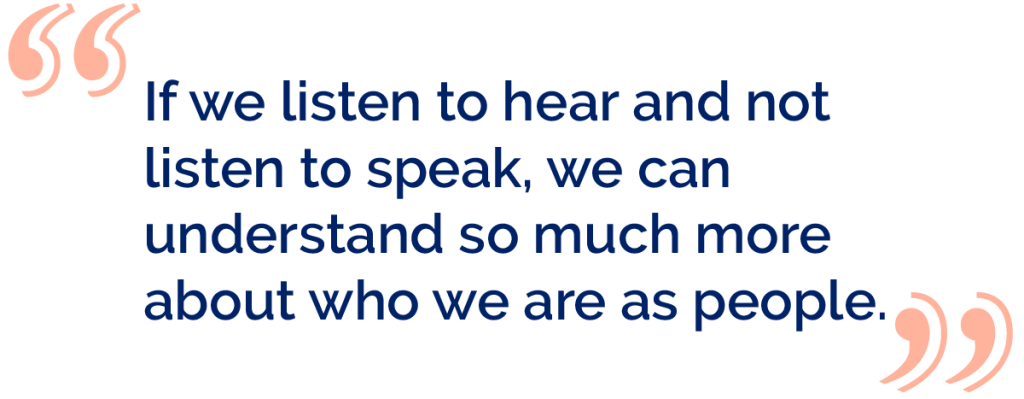
TW: I go back to listening to hear. In many conversations we’re not listening to hear, we’re listening to speak. And when you listen to speak you discredit what that other person is saying, because you’re not taking time to hear them. They’re telling you that they want this, and you can’t understand why they’re never happy. Well, it’s because this person says, I just need you to do this thing. And you’re missing it because you keep focusing on what you think it is.
If we listen to hear and not listen to speak, we can understand so much more about who we are as people. Every person wants to be heard, every person wants to be seen. That’s the reason we’re having this whole issue we’re having right now in America – one side doesn’t want to hear the other, and they’d rather call names to each other, not really sit down and say, if your view doesn’t align with mine let’s understand why. And I think that is the piece that makes the biggest difference, is just listening.
